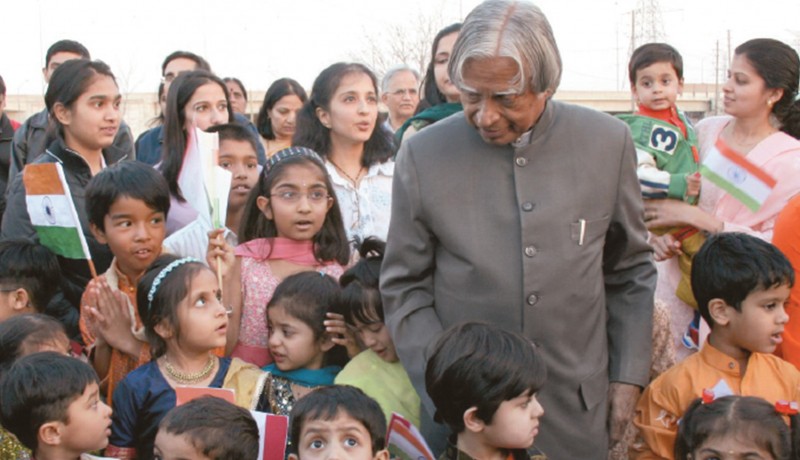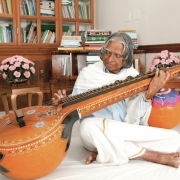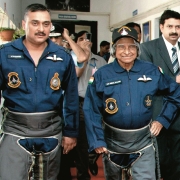
People

The wellness quotient of Dr A P J Abdul Kalam
A dream is not what you see in sleep; a dream is what does not let you sleep.” These words — his own — have defined the life of Abul Pakir Jainulbadeen Abdul Kalam. From a young boy who sold newspapers to support his education to a scientist-engineer and finally President of India, he has truly lived the dream. In fact, Kalam’s contributions to India’s satellite and missile programmes made him a household name in India long before he became president in 2002. In the next five years, he endeared himself further to millions of people across the country with his acuity and agility, intellect and dignity — all factors that make him the natural choice for Harmony’s fourth anniversary cover feature on ‘Wellness’.
This ‘People’s President’, who insists that he would rather be known as “a good human being”, retired from office in 2007 to settle down to civilian life in New Delhi. But Kalam, who turns 77 this October, still has a packed itinerary — he travels ceaselessly, speaking at several educational institutions and conferences across the country and overseas about his vision for a stronger India through connectivity for rural areas. He is also closely involved with the establishment of the country’s first space university in Thiruvananthapuram in Kerala. He took some time from his busy schedule to answer Harmony’s questions.
After being the country’s first citizen, how is civilian life treating you?
I am leading a very busy and invigorating life.
Would you like to go and live in Rameswaram, your native town?
My dear ones live there. I visit it once a year.
Who do you count as your closest friends today?
The youth of India.
How would you define ‘Total Wellness’?
Total wellness comes from the happiness you derive in ‘giving’. Giving means sharing what you have. It may be knowledge, kindness or alleviating pain.
Stem-cell research is a great future hope for the anti-ageing movement and indeed medicine in general. What are your views on this?
Even though stem cell science has led to many useful applications, it needs a lot of research. One important research area could be to help mentally challenged children. Regarding anti-ageing, experts have the answer.
According to you, what is the secret of your good health and super alert mind?
I am 100 per cent vegetarian. As for my mind, every morning I read almost all the newspapers in half an hour; I have access to radio and the Internet; I am still a learner of the Saraswati Veena; and I keep up to date on the latest developments in science and missile technology. Discipline and the company of good books and learned friends keep me alert.
Which books changed your life?
Thirukkural by Thiruvalluvar, the Tamil masterpiece on morals. Lights from Many Lamps by Lillian Eichler Watson, a compendium of the greatest ideas and philosophies. And Empires of the Mind by Denis Waitly, a guide to how change, innovation and responsibility can alter lives.
Which was the last book you read?
Five Minds for the Future by Howard Gardner, a visionary attempt to delineate mental abilities that will contribute to success in this day and age of accelerating change and information overload. The five minds are disciplined, synthesising, creating, respectful and ethical.
What do you enjoy doing in your free time — mind teasers, television or films?
I don’t indulge in any of these. I have not seen a movie in 50 years. I do enjoy classical music.
Your visions for India include “freedom”, “development” and “standing up to the world in order to be respected”. What do we need to do as a nation to transform them into reality?
We are on the ascending trajectory. What is important is the confidence that we can do it. This quality has to be inculcated in every youth of the country. Then, national development will accelerate.
How do we cultivate science and technology as ideology-free areas?
Every area of science normally leads to certain benefits to society. However, there are uses of science for weaponry too. It becomes a political decision. Making it an ideology-free area is the responsibility of the people who use science.
What, in your opinion, would be the spiritual approach to solving the nation’s problems?
Every religion has two components — theology and spirituality. Theology is exclusive for every religion, whereas spirituality is almost common for all religions. Spirituality can bridge the nation.
What role do you see yourself playing as a director on the board of CARE Group of Hospitals? In your previous term with the group, you facilitated the making of the ‘Kalam-Raju stent’.
The mission of the CARE group of hospitals is to ‘alleviate pain’. I participate in their mission.
How should India address the problem of health insurance for people over 60?
India needs health insurance for all citizens. That means the whole family. However, lack of physical and electronic connectivity hinders the widening of rural coverage. We need to work on this.
One of your messages to the youth is ‘Nothing is Impossible’. Would you say that nothing is impossible even for silver citizens?
Silver citizens have gone through both pleasant and rough times. Once in a joint family, nothing is impossible, even for silver citizens.
If you were to write the Silver Song (just like the Song of Youth that you wrote), what would it be?
The greatest asset for silver citizens is confidence in themselves and a young, cheerful mind. This would be the theme for my song. I saw a home where 50 silver citizens and 50 orphans live together. They support each other emotionally. As a result, they are physically and mentally healthy.
How can India’s silvers convert challenges into opportunities?
Old age homes should not be promoted as a business. Social organisations should always work to bring silvers back to their family and unite them. The youth must remember that senior citizens have unique experiences that are valuable to the family.
How can information and communication technology (ICT) empower seniors in India?
Some experiences of happy joint families in the country can be broadcast. Interactive websites can be created where silver citizens can share their joys as well as problems and concerns.
How can senior citizens contribute to the national prosperity index, which you define as “the summation of annual growth rate of GDP, improvement in the quality of life of people and adoption of a value system derived from our civilisational heritage in every walk of life”?
The foundation for the joint family system is the silver citizen. This should be promoted as the mission for the nation.
Finally, what are the lessons you’ve learnt from life that you’d like to share with our readers?
Radiate happiness. This state of mind attracts more friends and promotes happiness. Always see the strengths and good points of others.
Photo: Devi Images Archival Photo courtesy: Rashtrapati Bhavan Photo Section Featured in Harmony – Celebrate Age Magazine June 2008
you may also like to read
-
For the love of Sanskrit
During her 60s, if you had told Sushila A that she would be securing a doctorate in Sanskrit in the….
-
Style sensation
Meet Instagram star Moon Lin Cocking a snook at ageism, this nonagenarian Taiwanese woman is slaying street fashion like….
-
Beauty and her beast
Meet Instagram star Linda Rodin Most beauty and style influencers on Instagram hope to launch their beauty line someday…..
-
Cooking up a storm!
Meet Instagram star Shanthi Ramachandran In today’s web-fuelled world, you can now get recipes for your favourite dishes at….









